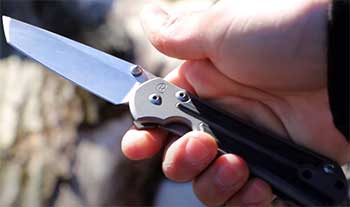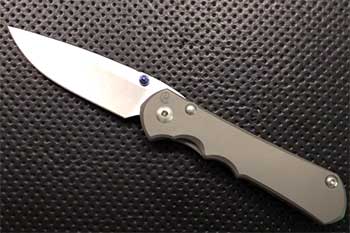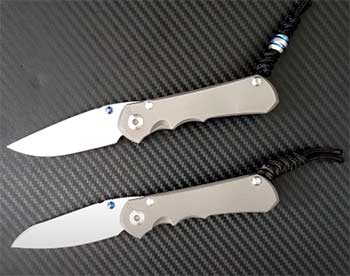The quality of Chris Reeve knives is always the best. They have different models and types of knives that you can use for various purposes.
Inkosi and Sebenza are two of their most famous, high-quality knives, and in this article, we will talk about these two.
Though Inkosi and Sebenza both almost look the same, they have some major differences also. For example, Sebenza is a bit heavier, less expensive than Inkosi, and great for everyday use.
Go through this article to see the detailed explanation of their features.
A Quick Comparison Table
This comparison table will give you a better understanding of these two knives and help you to easily choose between them-
| Specification | Inkosi Knife | Sebenza Knife |
| Type of use | Better for EDC | Better for everyday use |
| Weight | Lightweight, easy to carry | A bit heavy |
| Price | Expensive | Less expensive than Inkosi |
| Bushing Pivot | No | Yes |
| Design | Best | Better |
Key Differentiations Between Inkosi And Sebenza Knives
In this part of the article, we will dig deep into the detailed differentiations between Chris Reeve’s Inkosi and Sebenza knives-
- Uses of The Knives

Choosing the knives mostly depends on what type of work you want to do with them.
The Sebenza knife is made to be used in a wide range of tasks, including woodworking, metalworking, concrete work, tile work, and stonework.
If you deeply analyze the feature of Sebenza’s blade, then you can get an idea about which type of work you can do with it.
The blade of Sebenza has a traditional drop point design.
The spine of the knife has been rounded, which adds a very elegant touch. The blade is also very thick and sturdy (1/8′′ thick).
The blade successfully maintains this thickness and gradually cuts something down to a solid point. So, we can say that Sebenza is ideal for everyday work, especially for tough tasks.
On the other hand, Inkosi is a more aesthetic knife. Chris Reeve continues to develop the classic design into the most practical and ideal EDC companion.
The blade of the Inkosi is comparatively less thick than Sebenza, which is why you might not want to use it for a heavy task, but the other features have made the Inkosi knife perfect.
The Inkosi handles our everyday needs so nicely, for example, Christmas decorating and constant box or wrapping paper cutting.
- Cost Variation
Now it is almost clear that the Inkosi is kind of a successor of Sebenza. Inkosi was launched with more upgraded features like a locking mechanism, aesthetic design, etc.
You can already guess which one costs more between these two. Yes, Inkosi is costlier than Sebenza.
An Inkosi Black Canvas Micarta costs around $525, while a Sebenza costs $424, almost a hundred dollars less than the Inkosi knife. However, the Inkosi Plain Knife costs the same as Sebenza.
- Bushing Pivot

One thing that Inkosi does not have compared to the Sebenza knife is the bushing pivot.
With a bushing pivot, there is no need for adjustment because the pivot gets tightened while retaining smooth opening and closing.
The bushing pivot is one of the qualities of the Sebenza that many people consider evidence of its superiority. That’s why many customers say that they wish it had been incorporated into the Inkosi.
Overall, the Inkosi has a thicker pivot, the best locking mechanism, better durability, and a good blend of features. However, a bushing pivot could have made everything just perfect in Inkosi.
- Design and Quality Comparison
The Inkosi’s excellent build quality comes as no surprise, but its amazing design is absolutely adored by all. The knife is beautifully crafted.
With a smooth opening and good blade centering, it locks up with the same bank vault-like solidity that Chris Reeve knives have come to be known for.
It is totally frictionless or drop-shut smooth and has a pleasing velvety feel that gives you the ultimate comfort while opening or closing. You might miss this comfort in the Sebenza knife.
Also, the clip in Inkosi works pretty well, and it is simple to slide into and out of a pocket. You will absolutely like how they feel in your hand.
The Inkosi and Sebenza both have great appearances. But Inkosi has such a small handle that some of the customers feel like it is hard to work with this Inkosi knife.
However, the handle has a very nice curve which will give you a better grip than Sebenza. The grip will feel natural and keep your hand firmly in place.
If you’re used to the normal thumb stud, the cone-shaped thumb stud requires some time to get used to, but it functions nicely when pushed in a C form.
The blade’s shape of Inkosi is almost excellent; it has a traditional drop point shape with a well-rounded spine (which adds a surprisingly substantial feeling of luxury), a good amount of straight edge and belly, and a handy but robust tip.
It’s a knife that is incredibly well-made and has a design that deserves a lot of popularity.
Which One Stands Out?

Chris Reeve has a reputation for excellence for a reason. His creations are unparalleled, and for many collectors, the Sebenza stands at the top of the list.
It was first created in 1987 and was a knife that showed how good blades might be.
Since then, its sand-blasted titanium grip, satin-finished steel blade, and distinctive blue thumb stud have made it instantly recognizable.
Chris Reeve Knives has consistently improved over time by using different types of steel, adding beautiful inlays, and introducing a smaller size.
So the debate between Inkosi and Sebenza can be ended with just a sentence- if you want the premium feel with all the features, choose Inkosi. Otherwise, Sebenza can be a good choice for everyday use.
Frequently Asked Questions (FAQ)
Chris Reeve Inkosi is kind of an upgraded version of Sebenza. They are very similar in appearance, but Inkosi went through some improvements and upgrades, such as a stronger stop pin and additional locking mechanism stability, etc.
Sebenza 21 came out in May 2008, and almost after eleven years, Chris Reeve decided to discontinue it. Finally, Sebenza 21 was discontinued in June 2019.
According to CRK, 20 degrees is the best angle to sharpen Sebenza. But it does not have to be exactly 20 degrees. An angle between 15 to 20 degrees is perfect for sharpening Sebenza.
A Sebenza 31 is the newest version of Chris Reeve Knives’ iconic design. Both large and small variants are available, and it has some excellent upgrades, including better ergonomics and tolerances, a ceramic ball lock bar, and a pocket clip that sits off the lock bar.
Final Words
Being unbiased when discussing a Chris Reeve knife is quite challenging. Chris Reeve Knives, particularly the Sebenza line and the current Inkosi line-up, have almost all the necessary features and specifications that a customer might need.
Now it’s in your hand which one you want to buy. Inkosi or Sebenza’s dilemma can be solved easily if you can evaluate your needs or wants first and then select the knife according to that.

Are you confused regarding which knives you are describing? The blade is in fact thicker on the Inkosi, they are the same price if built with the same scales etc. They have the same frame lock mechanism etc. There is other misinformation in your review. I would check your facts before making so many incorrect statements.